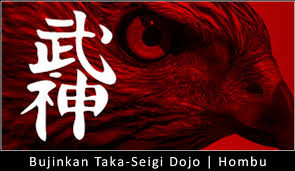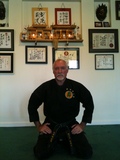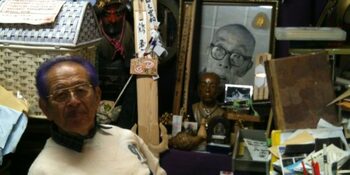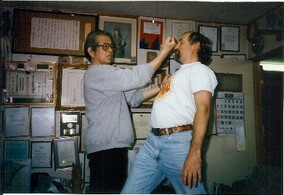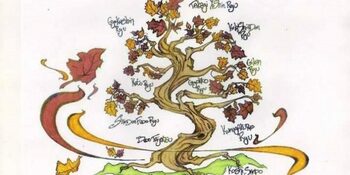
The Way It Was Part III
10.12.18
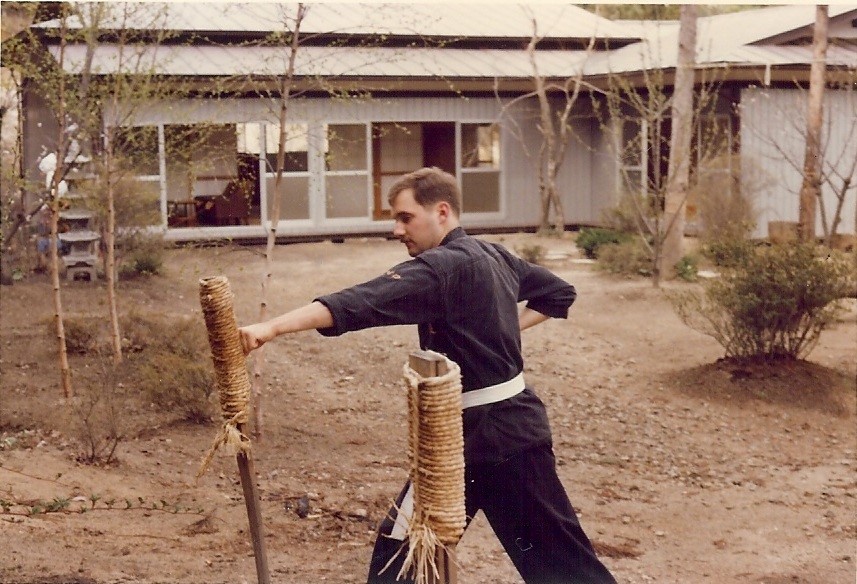
Mountain Training , Demonstrations and Being Japanese —
So it was in my early days of training in Chugoku KuKempo that it was pretty tough. I mentioned earlier about the mountain training we did in both summer and winter. In winter we had the snow and ice and cold to deal with. In summer it was the heat and mosquitoes. We much preferred summer training to that in the winter!!
Typically we would show up and clean the dojo thoroughly and get the fire going in preparation for when Sensei Fukuda or one of the senior black belt instructors showed up to teach. The dojo had a nice wooden floor that we would clean by run up and down on our hands and knees pushing damp onsen towels. This was great training in and of itself. It strengthened our legs, hips and shoulders and worked our flexibility too.

Hitting the Makiwara in 1978
After doing kata and exercise training in the dojo, we would go outside to work to toughen our hands and feet on the various makiwara. A number of trees were wrapped with rope that we used to develop strong kicks and tough calluses on our feet. You may recall one of Soke’s early videos that showed the Japanese Shihan doing nature training on trees and rocks to toughen up. This was similar to that kind of training. There were a few makiwara posts sunk in the ground and wrapped with hemp to strike to toughen our hands and develop powerful snapping punches. Typically we would have to kick trees 500 times each leg and punch the makiwara 500 times with each hand. This was really, really hard to do until you developed enough callus to withstand all those blows! No matter how much callus you had built up, eventually the skin tears and you are punching and kicking a bloody mess!
On one occasion with Sensei Fukuda was present, he paid particular attention to my punches. This was during a winter training cycle. I was barefoot in the snow with just gi pants on and no top. It was probably about 20-25F degrees out and we were doing conditioning training to our entire body. Sensei would say how weak we would be if we developed strong punches, but did not condition our legs as well. Or if we trained our legs and arms to be strong, but we were susceptible to the cold. The idea was not to leave a weakness or gap that an opponent could exploit. So having done my running through the ice and rocks of the near frozen stream, then done my 500 kicks each leg, now I was working on my punches on the makiwara when Sensei approached me. Ma te Firyu-kun he said, meaning for me to stop punching. He looked at my bloody knuckles of my right had and said make a fist and stick it in the snow. I want you to clean off your fist so I can see the knuckles. I did so and then showed him my fist. He grabbed it with his left hand and looked at them and smiled. Then he swung a hammer that he had hidden behind him in his right hand and broke my first two knuckles on my right hand. He then said, snow, then makiwara 100 times, then snow, then makiwara 100 more times. Repeat to 500 punches. He then walked away.
So there I was, bleeding and in a lot of pain because Sensei had just crushed my two knuckles on my right hand. And how I am hitting the makiwara, whack, whack, whack. I have to go to my happy place just to get through the pain of it all. The snow helps to deaden the pain a little bit. My punches are not very strong, just they are punches and I gut out 500 of them on the right. Sensei tells me later that the goal is to build up more calcium between the two broken knuckles and more or less merge the two into one big knuckle. I asked him what happens to my hand later in life? He said, “If you keep hitting the markiwara you will be fine. If you stop, you will become a cripple and have arthritis.” He wanted to break my right knuckles at least one more time and after they healed work on my left knuckles. I could understand developing callus over the skin, but not to break the skeletal structure to create something new. I told Sensei that I thought that was going beyond the natural order of things and if it was okay with him I would continue the makiwara, but I did not want my knuckles broken again. To my surprise he laughed and said of course, you are not Japanese. That probably hurt my feelings more than anything he could have said. I had tried for years to BE Japanese. Everything I did, everything I thought, everything I studied, everything I ate and drank was Japanese. I dreamed in Japanese often. I had recurring dreams of 300-400 years ago fighting on a battlefield in Japanese armour. I was engaged to a Japanese and wanted to spend the rest of my life in Japan. How could he say that ??!! About me of all people !!!
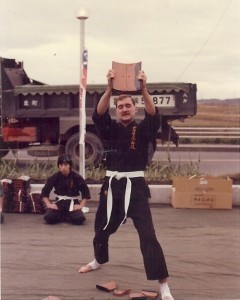
Breaking Demo
So I guess I am a bit slower than most, but eventually I came to realize that no matter what, I would never be truly Nihonjin to the Japanese. I might get close, but that is it. I would always be a Gaijin (foreigner), maybe even Henna Gaijin (strange foreigner) to them. This was a real epiphany to me. It shaped how I looked at my life in relation to the Japanese. From that day forward I decided to be happy with who I was. I would still dedicate 120% to my training, but I was okay being the Henna Gaijin studying Japanese budo. I embraced it and have thrived in everything I have studied or done in Japan since.
So this was the mountain training. I would lead a bunch of white belts up to the mountain dojo on numerous occasions without Sensei or one of the black belts being there. We would train on our own and practice doing breaking techniques on roofing tiles and boards and bricks that were there on the property. Sensei liked to do demonstrations so he had a bunch of breaking material stored there for these occasions. The first thing I ever broke was a kawada (roofing tile) on my head. In fact it was three of them. This was at a Mitsubishi car dealership opening for a friend of Sensei’s. My brand new white belt hanging down below my knees, my gi pants rising up near mid-calf, I must have been an awesome sight !! I had only been training or about a month or two and got to call to show up and be part of the group of students watching the demo. Others, more senior would do the actual breaking. So I showed up and we did the bow in and then some line punching, kicking and blocking at each other, then we sat off to the side and watched the seniors break everything from ice, to cinder blocks to roofing tiles and boards with their heads, hands and feet. To my shock, Sensei Fukuda called me up by name to break three kawada on my head. I had to ask one of the senior Gaijin, Don Hendricks, how do I hold them and where do I hit on my head exactly? With about 20 seconds of instructions there I was out in front getting ready to bash my head with these tiles. Sensei gave a loud OSU !! And I pulled the tiles into the crown of my forehead. Unfortunately, I didn’t pick up the most important concept about breaking something on your head. DON’T STOP !! I did and only one tile broke. It fell out of my hands and one half landed point first on top of my foot !! Now I had a headache and a bleeding and possibly fractured foot !! Sensei again yells out OSU !! Don whispers, “Don’t stop Phil !!” I do it again and break these two much easier than the first one. Added bonus, the pieces go flying safely behind me due to momentum.
After that demonstration, I vowed to become an expert breaker of things and would go up to the mountain dojo and practice on anything I could find. I even taught the white belts that came after me how to break, just in case they got called out at a demo some day. We had great fun almost knocking ourselves out sometimes. Did I mention I was a bit slow?
I participated in probably close to 20 demonstrations in the two and a half years I lived in Misawa and trained in Chugoku KuKempo. I learned how to break boards, bricks, roofing tiles, ice and bottles. The hardest by far was breaking the neck off of an empty beer bottle. I was only able to do it once cleanly. One of the senior black belts was an expert at this. He could do 10 bottles in a row without a miss. Stand an empty beer bottle up on a table and take a horizontal ometo shuto swipe at it and try to cut the top off. Give it a try and let me know how you do. A hint is to use a taller pint size bottle not a 12 oz one. I assume no liability if you cut yourself or injure a bystander when doing this. You are totally on your own. Instead of trying this, take my word for it that its freaking hard to do !!
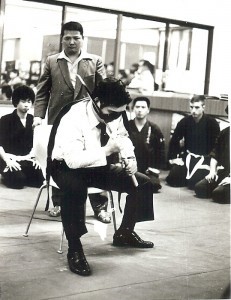
Fukuda-Sensei Sword Demo
Eventually I could do flying sidekicks into a stack of tiles or boards held by two or three people. Mr. Takada’s specialty was breaking a very large amount of ice with his head. He would put a huge rectangular block of ice on top of two cinder blocks. This ice was probably 10-12 inches thick!! He would put a folded Onsen towel on the center where his head would make contact. Then taking a deep stance in front of the ice he would drive his head down onto the towel with such force that the ice would crack. I later figured out the trick to this was in getting a long slab of ice to be suspended between the blocks. The weight of the ice itself helps with the breaking. It was, however, extremely difficult and impressive. Once time for show they put lighter fluid on top of the ice and lit it off. Mr. Takada had a bandana wrapped around his head for the head butt.
Sensei had two really cool tricks that he would do at some of the demonstrations. One was to tie a very sharp katana blade to his cheek with his obi. He would then pull the length of the blade along his cheek and then out of the obi. He would not be cut or even have a red line showing where the blade rested on his face. I am not sure how he did that. Possibly he turned the blade slightly away from his cheek when he pulled. Or there may be some dynamic of cutting that he exploited to avoid getting cut. I am not sure. It was pretty impressive though.
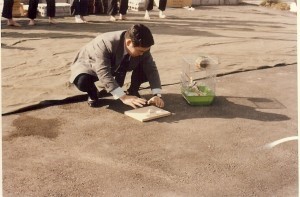
Fukuda-Sensei Bird Trick
The other trick Sensei did was take a small song bird out of a cage and while holding it in his left hand on the ground he would do a horizontal cut in the air above the bird while exhaling very loudly. He would then let the bird go and it would just lay there stunned. He said he paralyzed the bird with his “Ki.” He would then do it again and the bird would wake up and try flying away. This was another really cool trick, but I learned how it works. While holding the bird in his left, he would use his left ring finger to apply pressure on the little bird’s sternum area. This would temporarily paralyze the little bird. To revive it, he would rub the same area gently. Everyone was watching his other hand that waved over the top of the bird, not the hand that was holding it. Soke writes about these and other martial arts tricks in his book, “The Essence of Ninjutsu.”
Feel free to leave your thoughts, or a story of your own in the comments!
